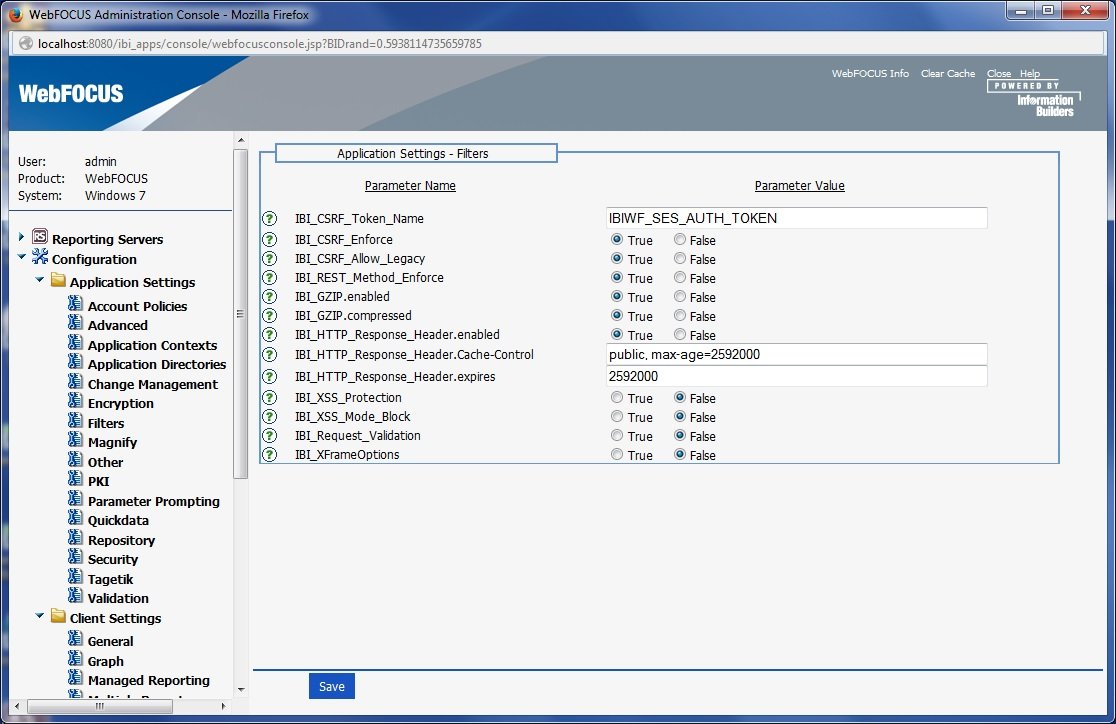Cross-Site Request Forgery (CSRF)
A Cross-Site Request Forgery (CSRF), also known as a
one-click attack or session riding, is a type of malicious exploit
of a website whereby unauthorized commands are transmitted from
a user that the website trusts.
To prevent these types of attacks, WebFOCUS must be configured
to use the CSRF token functionality. After this configuration is
completed, a CSRF token is generated every time the WebFOCUS RESTful
Web Services authentication request (IBIRS_action=signOn)
is run, in which the token would be returned within the response.
This token is then required to be sent as a parameter to all WebFOCUS
RESTful Web Service requests that perform Create, Update, and Delete
operations. These types of requests must be performed through an
HTTP POST method.
The CSRF token prevents attacks by checking for an encrypted
value that was generated randomly and then stored in the web session
of the actual authenticated user. This feature is not supported
for Kerberos and SSO environments.
x
Procedure: How to Enable and Configure the CSRF Token Functionality
To
enable and configure the CSRF token functionality:
-
Log on to the WebFOCUS Administration Console.
-
In the left pane, expand Configuration, Application
Settings, and then select Filters,
as shown in the following image.

-
Set the IBI_CSRF_Enforce and IBI_REST_Method_Enforce parameters
to True.
The following table lists and describes the parameters
related to CSRF token functionality that are available in the Application
Settings - Filters pane of the WebFOCUS Administration Console.
|
Parameter
|
Description
|
|---|
|
IBI_CSRF_Enforce
|
Requires all POST requests to provide a
CSRF token to be validated, except for legacy requests, if the exception
is allowed by the IBI_CSRF_Allow_Legacy parameter. The default value
is set to False.
|
|
IBI_CSRF_Allow_Legacy
|
The default value is set to True,
which allows legacy WebFOCUS Servlet requests to run without requiring
or utilizing a CSRF token.
|
|
IBI_REST_Method_Enforce
|
If set to True, this parameter specifies
that RESTful Web Services operations that Create, Update, or Delete
can only be run with the HTTP POST method. The default value is
set to False.
Note: If the IBI_CSRF_ENFORCE parameter
is set to True, then RESTful Web Services also require a
CSRF token. The token name is specified using the IBI_CSRF_Token_Name parameter.
|
|
IBI_CSRF_Token_Name
|
Specifies the name of the CSRF token.
The
default value is IBIWF_SES_AUTH_TOKEN.
|
xActions Requiring a CSRF Token
If WebFOCUS is configured to use the CSRF token functionality,
then the following is a list of WebFOCUS RESTful Web Services actions
(IBIRS_action), which require a CSRF token to be passed in
the request:
- addRule
- addUserToGroup
- copy
- delete
- listRulesForResource
- listRulesForRole
- listRulesForSubject
- move
- publish
- put
- removeRule
- removeUserFromGroup
- rename
- unpublish
x
The CSRF token is returned in the response of the WebFOCUS
RESTful Web Services authentication action (IBIRS_action=signOn),
as shown in the following image.

In this example, the name of the CSRF token is IBIWF_SES_AUTH_TOKEN and the
value for the CSRF token is 015a794691fe6a67b8ae059e0d506596.
x
If WebFOCUS is configured to use the CSRF token functionality,
then the CSRF token is passed as a parameter within the body of
the POST request for all actions that require a CSRF token.
Example:
The following example shows the WebFOCUS RESTful Web Service
request to add a user with a CSRF token.
Post Request URL:
http://localhost:8080/ibi_apps/rs
Body:
IBIRS_path=/SSYS/USERS/testuser&IBIRS_action=put
&IBIRS_object=<object _jt="IBFSUserObject" description="Test Userid" email="restid@informationbuilders.com" password="rest" type="User">
<status _jt="IBSSUserStatus" name="ACTIVE"/>
</object>
&IBIRS_service=ibfs&IBIWF_SES_AUTH_TOKEN=015a794691fe6a67b8ae059e0d506596
If the CSRF token is not sent or an invalid CSRF token is sent
in requests that require a CSRF token, then the following error
message will be returned in the response:
<!DOCTYPE HTML>
<HTML>
<HEAD>
<title>403 - Access Denied</title>
</HEAD>
<body style="background-color:#dae1e7; margin:0;">
<div align="center" style="position:relative;font-family:Arial;top:172px;font-size:25pt;">403 - Access Denied</div>
<div align="center" style="position:relative;top:178px;font-size:9pt;font-family:Tahoma;color: #485059;">You are not authorized to view this page</div>
</body>
</HTML>

